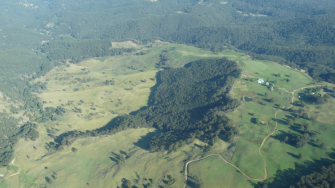
Date: Friday, October 16, 2015
Project: Eastern Australian Waterbird Survey
Observer - Terry Korn
Today we were in the home straight. Just a short run from Armidale down to the Upper Hunter to count some small storages around Liddell Power Station and a count down the Hunter River to complete the coastal end of Band 4, near Singleton. And then off to Bankstown. Eleven days away in a small plane makes you appreciate the comforts and routine of home.
Clearing Fog after take-off at Armidale. Photo: Terry Korn
Fog at Armidale delayed our departure by 30 minutes but once it cleared we were treated to a beautiful day and picturesque country from our little “home” in the sky. The tablelands are renowned for their cattle and sheep production, especially its fine wool from around Walcha and Woolbrook. A little south of Walcha excellent basalt country was cleared of its forest for property development in the 1960’s and 1970’s. With properties surrounded by forest, resident populations of wild dogs took to sheep like bees to honey and have been a management issue for landholders and the government land managers ever since.
A tablelands livestock production property surrounded by forest. Photo: Terry Korn
As we flew over the Hunter valley, another land management issue manifested itself in the form of coal mining. Here large swathes of prime agricultural land have been erased by massive open cut coal mines. The extent of this activity can only be appreciated from the air and once seen, one can understand the grief and tension it has caused in local communities. Vision downstream towards Newcastle is impaired by a permanent dust haze.
The Hunter River is now perched on the edge of this huge coal mine. Photo: Terry Korn
But back to birds! This long term study, now in its 33rd year, is probably one of the few which will inform community and governments of long term changes to the water environments.
One of the many coal mines in the Upper Hunter. Photo: Terry Korn
